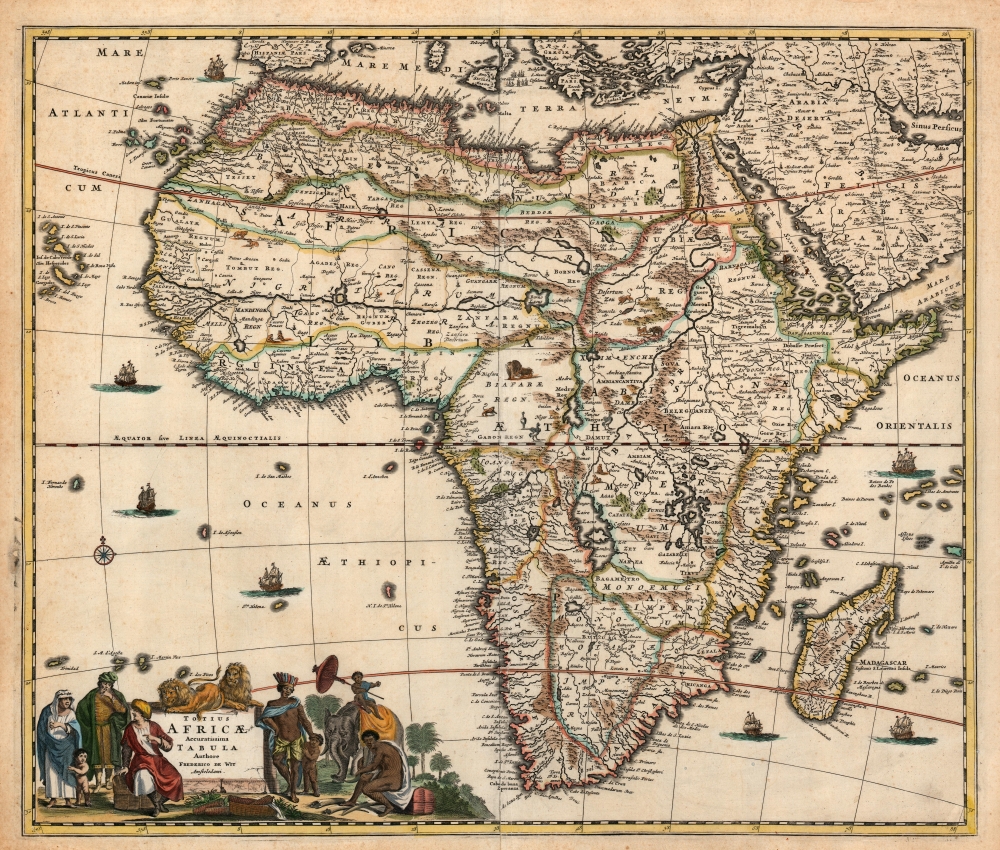This item has been sold, but you can get on the Waitlist to be notified if another example becomes available, or purchase a digital scan.
1685 Frederick de Wit Map of Africa
TotiusAfricae-dewit-1685
Title
1685 (undated) 19.25 x 23 in (48.895 x 58.42 cm) 1 : 17000000
Description
Cartographic Advances
This map follows the typical conventions of the period but exhibits several advances derived from judicious borrowing from earlier maps. The Nile follows the Ptolemaic model, drawing its waters from two great lakes in the southern part of the continent, Zembre (Lake Zaire) andZaflan. On the west coast of the continent, several Dutch trading stations, including Fort Nassau and Acara, are noted. It is curious that Dutch information from South Africa, however, is absent. In the Atlantic, here identified as the Oceanus Aethiopicus, the fictional island of Nuestra I. de Santa Helena, a common feature of contemporaneous French maps by Sanson and others, is identified.Publication History
This map was published by De Wit in Amsterdam. The map was first issued in 1670, and there are at least six states of the map, the present example being state 4, identifiable by the inclusion of additional information in the interior - such as the inclusion of Biafra and the lack of a privilege, a kind of early copyright, which was added in the 5th edition.Cartographer
Frederik de Wit (1629 - 1706) was a Dutch Golden Age cartographer active in the second half of the 17th and the early 18th centuries. De Wit was born of middle class Protestant stock in the western Netherlandish town of Gouda. He relocated to Amsterdam sometime before 1648, where he worked under Willem Blaeu. His first attributed engraved map, a plan of Haarlem for Antonius Sanderus' Flandria Illustrata, was issued around this time. He struck out on his own in 1654. The first chart that De Wit personally both drew and engraved was most likely his 1659 map of Denmark, REGNI DANIÆ Accuratissima delineatio Perfeckte Kaerte van ‘t CONJNCKRYCK DENEMARCKEN. His great wall map of the world and most famous work, Nova Totius Terrarum Orbis Tabula appeared one year later. Following the publication of his wall map De Wit quickly rose in prominence as a both cartographer and engraver. He married Maria van der Way in 1661 and through her became a citizen of Amsterdam in 1662. Around this time he also published his first major atlas, a composite production ranging in size from 17 to over 150 maps and charts. Other atlases and individual maps followed. In 1689 De Wit was granted a 15 year Privilege by the Dutch States General. (An early copyright that protected the recipient's rights to print and publish.) He was recognized with the honorific 'Good Citizen' in 1694. De Wit died in 1706 after which his wife Maria continued publishing his maps until about 1710. De Wit's son, Franciscus, had no interest in the map trade, instead choosing to prosper as a stockfish merchant. On her own retirement, Maria sold most De Wit maps and plates at a public auction. Most were acquired by Pieter Mortier and laid the groundwork for the 1721 rise of Covens and Mortier, the largest Dutch cartographic publishing house of the 18th century. More by this mapmaker...

